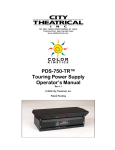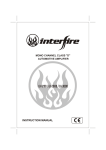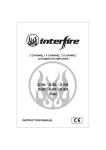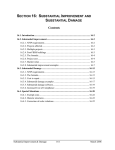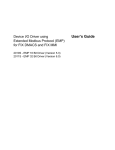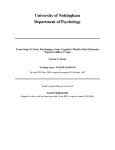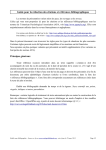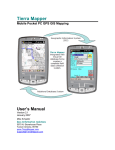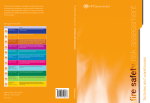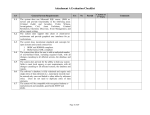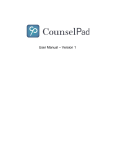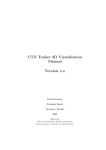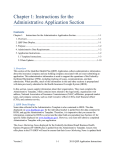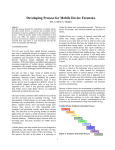Download 20 FST 4084 - University of Cincinnati
Transcript
University of Cincinnati 20 FST 4084 FALL 2012 Fire Investigation & Analysis Course Syllabus Introduction and Instructor Contact Welcome and congratulations for enrolling in the Fire Investigation and Analysis course. • Course instructor o Randall W. Hanifen, FO, MIFireE o E-mail at [email protected] (accepted 24/7 and returned in 48 hours) o Phone: (513) 266-6124. (accepted until 22:00) Course Description This course examines the technical, investigative, legal, and social aspects of arson, including principles of incendiary fire analysis and detection, environmental and psychological factors of arson, legal considerations, intervention, and mitigation strategies. At the conclusion of the course, the student should be able to: 1. Demonstrate a technical understanding of the characteristics and impacts of fire loss and the crime of arson necessary to conduct competent fire investigation and analysis. 2. Document the fire scene, in accordance with best practice and legal requirements. 3. Analyze the fire scenario utilizing the scientific method, fire science, and relevant technology. 4. Analyze the legal foundation for conducting a systematic incendiary fire investigation and case preparation. 5. Design and integrate a variety of arson related intervention and mitigation strategies. Course Design The course is divided into five modules. These modules are: Module I: Introduction to Fire Investigation and Analysis Module II: Origin and Cause Determination Module III: Fire Analysis Module IV: Incendiary Fire Investigation Module V: Strategies for Combating Arson Within each course module, there will be a module overview, a module lecture, module discussion question(s), and assignment questions for the module. Module 1-4 will have a duration of three weeks. Module 5 will have a duration of 2 weeks, which will fulfill our fourteen-week semester. Required Texts The texts and other learning materials required for the course are: 1. Fire Protection Handbook (National Fire Protection Association), Volumes I and II, Arthur E. Cote (Editor), 20th edition (January 1, 2008). Publisher: National Fire Protection Association; ISBN #: 10: 0-87765-758-0 2. NFPA 921: Guide for Fire and Explosion Investigations, 2011 Edition, ISBN#: 978-161665714-7 3.User's Manual for NFPA 921: Guide for Fire and Explosion Investigations, 2004 Edition, Item#: 921GD05 4. interFire VR CD-Rom, 1999, Stonehouse Media Incorporated. In addition to the texts, you will be reading a number of course documents, articles, online resources, and web-based research articles. Supplementary Readings There are also a number of online readings that you are encouraged to read or explore based on your interest in the topics. Note: You are not expected to read all the supplementary or optional readings, only those that you choose for your article reviews and to support your discussion arguments and assignments. Read most carefully the sections you will either discuss with the class or use for your assignments. Required Computer Hardware and Software You will be asked to explore interactive, media-rich websites using the Internet. Some may use multimedia components, such as audio tracks, video, etc. The multimedia features provide a richer experience for the viewer by using sound and movement to make content come alive. Your computer should have a sound and video card. Some of these sites require you to download special software programs called plug-ins. Plug-ins allow your web browser (Internet Explorer, Netscape Navigator, etc.) to view or play certain types of files. The plug-ins are free and download quickly. Discussion Questions You will participate in discussions designed to advance your project; help you master course concepts; and encourage you to evaluate, analyze, and synthesize information. The course discussions are not casual conversations; they are individual reporting spaces in which you share your reports with the group and respond to your colleagues' work in the same manner that you might do in professional environments. Each discussion requires preparation, information gathering, and additional reading. Discussion Due dates are: • First Discussion Question initial response by Wednesday of Week 1 of the module and a reply by Friday of Week 1 • Second Discussion Question initial response by Wednesday of Week 2 of the module and reply by Friday of Week 2 of the module Assignments There are several written assignments in this course that serve to assist you in gaining a better understanding of the fundamental design principles related to structural fire protection, building furnishings, and fire protection systems. These assignments will conclude each module and will be due on the Friday of the third week of the module, with the exception of Module 5, which will be due Friday of the second week. The assignments are located in the assignments portion of Blackboard and submission should be to the assignments tab under the appropriate assignment. Label the file of the assignment (484 Last name, First Initial-Assignment number, e.g. 484 Doe, J-Assignment 1). As with any fire service position, punctuality is important, therefore, I expect you to submit assignment and discussion questions by the due dates. If you have an issue, which prevents you from complying, please relay this to me so we can make arrangements. If the coursework is completed late, the instructor will lower the grade by 5% per day. Let’s work together for timely completion of the assignments and discussion questions The assignments are as follows: Module 1 (Week 1, Week 2 and Week 3; due Friday of Week 3) For this assignment, select two property types (i.e., schools, churches, businesses, etc.) that are prone to arson. Find data on those two properties. Based on the data you find, analyze trends. How do these compare to your community? Then make some fire prevention strategy recommendations for both property types that you are examining. Substantiate your statements with at least two references that provide supporting data and/or relevant articles. Your essay should be 4-6 double spaced pages in length. The essay should have a formal introduction, a statement of purpose on the first page, a body, and a conclusion. Be sure to credit all sources. Your paper should meet the requirements of the American Psychological Association’s (APA) th 6 edition for Manuscript preparation related to formatting, writing style, and citing references. Information related to APA guidelines can be found on-line at http://www.apastyle.org/ Module 2 (Week 4, 5, and 6; Due Friday of Week 6) For this assignment you will be visiting the interFire Online website's training modules area. The training modules area has many interactive tutorials on critical fire and arson investigation procedures. You will be using the First Response from an Investigative Perspective training module for this assignment. This interactive tutorial allows you to view the same incident from the experiences of fire, police, and EMS professionals. First responders are in a unique position to observe and record conditions and behavior that may be critical in the investigative phase. This training module will let you see how their perspectives of the incident differ, and learn how they can improve their response skills. You will learn how to properly work with first responders to gather as much investigative information as possible. Step 1: Go to interFire's First Response from an Investigative Perspective training module at http://www.interfire.org/training/firstresponse.asp. Step 2: At the bottom, next to "Dispatch," select one of the 3 groups: fire, police, or EMS. Listen to the audio for instructions and click on "continue/forward" when you are ready to proceed. Step 3: Click on the pictures under the words "training center" to view your responsibilities, which will be different depending on what group you selected. Be sure to move your cursor over the images to view different notes. When you are done viewing, click on "respond/now." Step 4: Listen to the audio for instructions. You will be asked to focus and view the video. After the video, click on "forward" at the bottom right hand side of the screen. Step 5: Finally, take the quiz. The quiz asks you to answer the investigator's questions. You will be given the opportunity to replay the video during this step if necessary. The next "debriefing" section is optional. Step 6: Send your quiz score to your instructor. Write a short explanation of what group you selected and explain why, how you did, and how you could improve. Step 7: You will now play the role of investigator, assigned to work with a first responder to gather as much investigative information as possible. Select a different first responder from the groups (fire, police, EMS), write a short essay that addresses the following: • • • • • • How would you follow the basic steps of fire investigation? What is the significance of preserving the fire scene? How would you go about determining origin and identifying the cause? How do you interpret the fire patterns? Draft some questions that you would ask the first responders. How would you document the fire scene? Your essay should be 4-6 double spaced pages in length. The essay should have a formal introduction, a statement of purpose on the first page, a body, and a conclusion. Be sure to credit all sources. Your paper should meet the requirements of the American Psychological th Association’s (APA) 6 edition for Manuscript preparation related to formatting, writing style, and citing references. Information related to APA guidelines can be found on-line at http://www.apastyle.org/ General Instructions for Written Assignment Your written assignment is intended to test your understanding of important concepts and sharpen your intellectual skills of analysis, synthesis, evaluation, and application. The intent of the written assignment is to provide an opportunity to more fully describe, explain, and analyze the books and other sources. Module 2 B Read the following article by David J. Icove, V.B. Wherry, and J. D. Schroeder, Combating Arson-For-Profit: Advanced Techniques for Investigators. Columbus, OH: Battelle Press, 1980. Combating Arson-For-Profit by Icove, D.J., et. al 1998.pdf locate in the course resources section. The case study traces the process of an arson investigation. It is based on an actual investigation; however, the names have been changed. As you read through the case study, jot down which of the 5 steps in a comprehensive incendiary investigation are reflected in the investigation report. Then, write a short essay that addresses the following: 1. Identify the persons who should be interviewed during the investigation. 2. Develop a list of questions and cite your methodology in securing the interview. For example, I would interview the Incident Commander (fire chief). Purpose of the interview would be to address initial conditions, suppression tactics, hose line advancement, etc. The interview would be initially conducted at the scene if possible and subsequently followed up if additional information is needed. Your essay should be 4-6 double spaced pages in length. The essay should have a formal introduction, a statement of purpose on the first page, a body and a conclusion. Be sure to credit all sources. Your paper should meet the requirements of the American Psychological th Association’s (APA) 6 edition for Manuscript preparation related to formatting, writing style, and citing references. Information related to APA guidelines can be found on-line at http://www.apastyle.org/ Module 3 (Week 7, 8 and 9; Due Friday of Week 9) Module 3A Michael Faraday (1791 - 1867), an English physicist and chemist, developed a series of lectures called Christmas lectures because they were given to young people during the holidays. One of his more popular lectures was The Chemical History of a Candle which can be found at http://www.gutenberg.org/files/14474/14474-8.txt. In the 1850s the lectures were documented. Faraday considered the physical phenomenon of a candle to be an open door to the study of physics. This hands-on activity will allow you to observe a lit candle and record those observations following the steps as outlined below. Step 1: Gather the following materials: • • • • • • • • • Non-combustible work surface Taper type candle with stable candle holder Wood matches Index cards Pliers Old metal spoon Drinking glass Container with water for extinguishing matches and cards Safety glasses Step 2: Prepare a safe area to burn a candle. Place the candle in the holder on a noncombustible work surface, such as a metal cookie tray or a glass cutting board. Keep other fuels (like your hair or your shirt sleeves) away from the candle. Step 3: Light the candle with a match and safely dispose of the match. Take notes that address the following: • • • • Describe the areas of the flame in terms of color and transparency. Explain the different areas of the flame. Explain how a candle works. What type of flame is it? Step 4: Light a second match, then blow out the candle flame. Bring the lit match to the smoke about an inch above the wick. Take notes that describe what is happening and explain why. Step 5: Light the candle again. Pass the spoon through the flame. Take notes that describe what is happening to the spoon and why. Step 6: With the candle lit, place your hand approximately 3 to 4 inches (100 mm) to one side of the candle flame. Then carefully move your hand to a position approximately 3 to 4 inches over the top of the candle flame. Do not burn your hand. If your hand is getting too hot, move it away from the flame. Take notes that describe in what position was your hand was the warmest. Explain why in terms of heat transfer. Step 7: Using your notes, write a short essay approximately 2-4 double spaced pages in length that answers the above questions. The essay should have a formal introduction, a statement of purpose on the first page, a body, and a conclusion. Be sure to credit all sources. th Your paper should meet the requirements of the American Psychological Association’s (APA) 6 edition for Manuscript preparation related to formatting, writing style, and citing references. Information related to APA guidelines can be found on-line at http://www.apastyle.org/ Module 3B interFIRE VR is a software that was developed over a period of more than two years by fire investigation experts from ATF, the U.S. Fire Administration, the NFPA, and American ReInsurance Company. The resulting interFIRE VR is an interactive, virtual reality CD-ROM that provides both a strong overview and specific detail on all aspects of fire investigation using an interactive interface. The goal of interFIRE is to improve the effectiveness of the fire investigation process by raising the base level of knowledge of all fire investigators by training investigators and student investigators through instruction in the best practices in core critical actions before the fire, at the fire scene, and in the follow-up investigation. These best practices are a "street proven" systematic protocol for investigating a fire. The interFIRE VR CD-ROM is easy to use once you get familiar with its four components: • • • • Tutorial: a step-by-step guide to preparing for a fire scene investigation, investigating the fire scene, and following up the scene investigation Resource File: a compendium of articles, abstracts, resources, and photographs on indepth fire investigation topics Scenario: a very interactive, "virtual reality" practical exercise where the users conduct a real fire investigation on their computer, with constant feedback on progress. You will need several hours to complete the investigation. Most people work over a period of days to complete the investigation. Your work will be saved each time you leave to take a break. When you are ready, you must enter the scene, examine it, interact with your team, interview witnesses, and collect evidence, much like an actual investigation. If you don't work, neither will the program. Motivation and discipline are required. Your work will be rewarded. Website: the interFIRE website at http://www.interFIRE.org is an Internet resource updated regularly that keeps fire investigation professionals up to date on breaking legal and technical developments in the field. Resource File: a compendium of articles, abstracts, resources, and photographs on in-depth fire investigation topics Scenario: a very interactive, "virtual reality" practical exercise where the users conduct a real fire investigation on their computer, with constant feedback on progress. You will need several hours to complete the investigation. Most people work over a period of days to complete the investigation. Your work will be saved each time you leave to take a break. When you are ready, you must enter the scene, examine it, interact with your team, interview witnesses, and collect evidence, much like an actual investigation. If you don't work, neither will the program. Motivation and discipline are required. Your work will be rewarded. Website: the interFIRE website at http://www.interFIRE.org is an Internet resource updated regularly that keeps fire investigation professionals up to date on breaking legal and technical developments in the field. Walk Through the Fire Scene in interFIRE VR Now that you have studied the interaction of the fire and the room of origin, considering what you have learned about plumes and the interrelationship of fuel, compartmentation, ventilation, and heat release rate, walk through the fire scene in interFIRE VR. Follow the fire flow from outside of the structure into the structure. Watch the Video Watch the following video and note that in both cases, the same amount and type of fuel (polyurethane foam) are used. Also, a similar ignition source is used in both cases. Explain why the fire growth is different in terms of geometry and heat transfer. Title: "Burning Foam Comparison" Video Length: 1:07 Click here for Broadband/DSL users Click here for Dialup users You will need the most recent Windows Media or Real Player installed on your computer to view this video clip. When you click on one of the links above, the video will launch your media player and begin playing automatically. Observe and Document the Following As you are moving through the structure, note the following: • • • • • • Where was the fire getting air from? Where were the hot gases going? How does the fire flow lead you to the area of origin and why? Can you identify the pattern caused by the fire plume? What, if anything, affected the plume? What do the patterns and the lines of demarcation tell you about the fire? Write and submit an essay based on your observations. It should be 4-6 double spaced pages in length. The essay should have a formal introduction, a statement of purpose on the first page, a body, and a conclusion. Be sure to credit all sources. Your paper should meet the requirements th of the American Psychological Association’s (APA) 6 edition for Manuscript preparation related to formatting, writing style, and citing references. Information related to APA guidelines can be found on-line at the University of Cincinnati’s Library website. Module 3B (1) As mentioned earlier, it is important to know how to appropriately apply the equations for flame height and minimum energy required for a flashover based on a doorway ventilation. For this activity, submit an essay that addresses the following: 1. Find heat release rate data for an item (your choice) from a reliable and well documented source. Then using the peak or average heat release rate (HRR) value for the item, calculate flame height for the item for the following locations: a) in the middle of a room b) next to a wall c) in a corner. List your reference for the HRR data and use the equation given in NFPA 921 5.5.6.1. Be sure to explain the results of your calculations. You should also address the following: • • What other features of the fire and the fire plume might change along with the flame height? How might these changes affect fire growth in a compartment? 2. Next, assume the fire you identified above was in a 3.6 m x 3.6 m x 2.4 m room with a doorway that is 2 m high by 1 m wide and no other ventilation. Answer the following questions: • • Do you have enough energy to have a flashover in the room? Use the equation given in NFPA 921 Section 5.5.5.1.1. Explain your results. Your essay should be 4-6 double spaced pages in length. The essay should have a formal introduction, a statement of purpose on the first page, a body, and a conclusion. Be sure to credit all sources. Your paper should meet the requirements of the American Psychological th Association’s (APA) 6 edition for Manuscript preparation related to formatting, writing style, and citing references. Information related to APA guidelines can be found on-line at http://www.apastyle.org/ Module 3 B(2) You are called to a fire at a downtown hotel. The building is Type 1 construction. The damage in the room is consistent with post-flashover fire conditions. Looking at the remains of the furniture in the room and examining the adjacent (undamaged) hotel rooms, you notice that the rooms are sparsely furnished. Each room has a bed, a TV, and a shelf with a clothing rod underneath, as shown below. There were no witnesses. The tenant was a smoker. Photographs of the Room Submit an essay that addresses the following: Based on the amount of fuel and the potential amount of ventilation, discuss what analytical tools and techniques you would use to determine if this fire was unintentional or incendiary. Develop a list of questions that you would need answered in order to make the final determination. Once you have submitted the answers to the above, I will submit a response that will provide you with all the necessary data (fuel types, doorway dimensions, ceiling height, bed location, types of clothes on rack, and the type of mattress) so that you may: • • use formulas for Flame Height and Minimum Heat Release Rate to Flashover calculations and submit the calculations discuss what other approaches you would recommend to confirm your hypothesis Your essay should be 4-6 double spaced pages in length. You should use the http://www.bfrl.nist.gov website as one of your sources. Identify at least one other source. Be sure to credit all sources. Your paper should meet the requirements of the American Psychological th Association’s (APA) 6 edition for Manuscript preparation related to formatting, writing style, and citing references. Information related to APA guidelines can be found on-line at http://www.apastyle.org/ Module 4 (Week 10, 11 &12; Due Friday of Week 14) interFIRE VRAssignment Instructions It is anticipated that you will begin work on this assignment now, and continue working on it through the remainder of the term. By design, the interFIRE VR Scenario "drops" you in front of a fire scene with very little initial information. This situation closely mirrors what happens in real life. There are many, many ways to use the interFIRE CD but I have chosen an assignment for you to complete which is suitable for a novice investigator who is not familiar with the interFIRE software. I have chosen this path ("Learning Pathway 3: Directed") so that you can be successful and will have the support of stepby-step tutorials. While working on the Scenario, you will have the opportunity to go back into the investigation and complete the steps that you may have missed. Remember, this is a luxury that does not exist in the real world. Once the scene is relinquished/razed, a witness interview is missed, a piece of evidence overlooked, or a shortcut is taken in the overall scientific methodology, there may be no going back. Keeping a Notebook You need to keep a file that contains your notes. This digital file or digital notebook is where you can write the details of the incident and any investigative leads you uncover. This notebook will help you put the case together and you should split the notebook up into sections. You will be asked to submit this at the end of the course: • • • • • • witnesses evidence accidental causes leads to follow up insurance/financial information other Getting Started Place the interFIRE VR CD into the CD drive of your PC. Then work through the Scenario in a directed way by following the steps 1-12 below (you will complete steps 13-15 in the next module). You should rely on the online interFIRE Student Handbook which explains in detail how to move through each step successfully, at http://www.interFIRE.org/pdf/ifvrSTUDENT_HANDBOOK.pdf. • • • • • • • • • Step 1: Review the Tutorial Step 2: Select the Scenario and Read the Gameplay Step 3: Consult Professionals Step 4: Understand How the Scene Investigation Works Step 5: Secure the Scene Step 6: Put the Team to Work Step 7: Conduct Preliminary Scene Assessment Step 8: Interview the First Witness Step 9: Size-up the Fire Scene and Begin Documentation • • • Step 10: Examine the Scene, Eliminate Accidental Causes and Begin Collecting Evidence Step 11: Employ Canine Unit Step 12: Go For It! Module 5 (Week 13 &14; Due Friday of Week 14) Finish working your way through the interFIRE VR assignment Complete the investigation. Submit your Notebook You should have been keeping a file that contains all your notes detailing the incident and any investigative leads you uncover. This notebook should have helped you put the case together. You should submit this file now with the following sections: • • • • • • witnesses evidence accidental causes leads to follow up insurance/financial information other You should also include a written statement addressing steps 13 - 15: • • • Step 13: Specify Origin and Cause Determination Step 14: Follow-up Investigation Step 15: Virtual Prosecutor Grading/Evaluation Final course evaluation will be based on the following percentage weight of each type of learning activity: Participation in Course Discussion Area 20% Written Assignments 80% Total 100% The grading scale that will be utilized for assigning alphabetical grades to written work and how the alphabetical grades are calculated in the Blackboard grading system are as follows: Grading Scale Low High 94 100 90 93.9 87 89.9 84 86.9 80 83.9 77 79.9 74 76.9 70 73.9 67 69.9 64 66.9 60 63.9 0 59.9 Grade A AB+ B BC+ C CD+ D DF Calculated As % 95 91.5 88.5 85 81.5 78.5 75 71.5 68.5 65 61.5 55 Conclusion As we progress through the course, please feel free to contact me at any time. I look forward to a great quarter of learning together. Sincerely, Randall W. Hanifen, MS Randall W. Hanifen, MS Adjunct Instructor University of Cincinnati Fire Science















